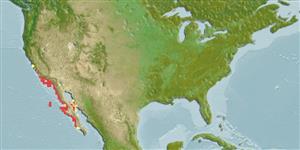>
Atheriniformes (Silversides) >
Atherinopsidae (Neotropical silversides) > Atherinopsinae
Etymology: Leuresthes: Greek, leyros, -a, -on = smooth + Greek, esthes = suit, something used to wrap (Ref. 45335).
More on author: Ayres.
Environment: milieu / climate zone / depth range / distribution range
Ecología
marino; rango de profundidad 0 - 18 m (Ref. 2850). Subtropical; 37°N - 24°N, 123°W - 111°W
Eastern Pacific: Monterey Bay, USA to Baja California Sur, Mexico.
Length at first maturity / Tamaño / Peso / Age
Maturity: Lm 11.9 range ? - ? cm
Max length : 19.0 cm TL macho / no sexado; (Ref. 2850); edad máxima reportada: 8 años (Ref. 1744)
Espinas dorsales (total): 4 - 8; Radios blandos dorsales (total): 8-10; Espinas anales 1; Radios blandos anales: 20 - 24; Vértebra: 47 - 50. Branchiostegal rays: 6 (Ref. 36497).
Adults inhabit inshore waters, usually at or near surface along open coast and in bays (Ref. 36497). Oviparous, with planktonic primarily neustonic larvae (Ref. 36497). Eggs are deposited in the sand at night by the female parent (Ref. 58332) just below the high spring tide line (Ref. 36497). Minimum depth reported taken from Ref. 57178.
Demersal spawners. Spawn at night on sand beaches at high tides in the spring and summer. Eggs are buried in moist sand by the female parent (Ref. 58332) and hatch about 15 days later during the next series of high tides (Ref. 2850). Females spawn 4 to 8 times during a season (Ref. 4563).
Eschmeyer, W.N., E.S. Herald and H. Hammann, 1983. A field guide to Pacific coast fishes of North America. Boston (MA, USA): Houghton Mifflin Company. xii+336 p. (Ref. 2850)
IUCN Red List Status (Ref. 130435)
Threat to humans
Harmless
Human uses
Pesquerías: escaso valor comercial
Más información
ReferenciasAcuiculturaPerfil de acuiculturaRazasGenéticaElectrophoresesheritabilidadEnfermedadesProcesamientoNutrientsMass conversion
ColaboradoresImágenesStamps, Coins Misc.SonidosCiguateraVelocidadTipo de nataciónSuperficie branquialOtolitosCerebrosVisión
Herramientas
Special reports
Download XML
Fuentes de Internet
Estimates based on models
Preferred temperature (Ref.
123201): 15 - 23.2, mean 21 °C (based on 103 cells).
Phylogenetic diversity index (Ref.
82804): PD
50 = 0.7500 [Uniqueness, from 0.5 = low to 2.0 = high].
Bayesian length-weight: a=0.00603 (0.00275 - 0.01321), b=3.01 (2.82 - 3.20), in cm total length, based on LWR estimates for this (Sub)family-body shape (Ref.
93245).
Nivel trófico (Ref.
69278): 2.9 ±0.4 se; based on size and trophs of closest relatives
Generation time: 3.3 ( na - na) years. Estimated as median ln(3)/K based on 2
growth studies.
Resiliencia (Ref.
120179): Medio, población duplicada en un tiempo mínimo de 1.4-4.4 años (tmax=4; k >0.30; tm=1.5).
Fishing Vulnerability (Ref.
59153): Low vulnerability (10 of 100).
